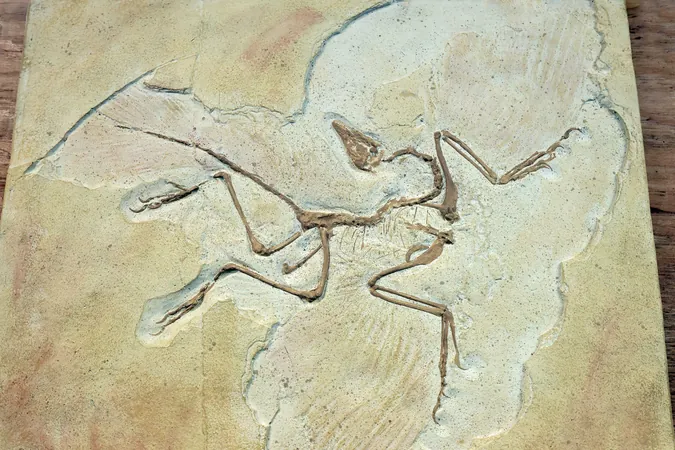
Ancient Fossil Sheds Light on the Evolution of Bird Intelligence
2024-11-13
Author: Olivia
Introduction
A groundbreaking fossil discovery has emerged, promising to reshape our understanding of the evolution of avian intelligence—one of the most intricate enigmas in vertebrate evolution. Researchers have unveiled a remarkably preserved bird fossil, roughly the size of a starling, dating back to the Mesozoic Era—a rarity for ancient specimens.
The Discovery
This one-of-a-kind find occurred at a site in Brazil, where paleontologist William Nava discovered the fossil in 2016. Over 80 million years old, this bird—named *Navaornis hestiae*—existed before the mass extinction event that eradicated non-avian dinosaurs. The fossil's almost complete skull, preserved in extraordinary three dimensions, allowed scientists from the University of Cambridge and the Natural History Museum of Los Angeles County to digitally reconstruct its brain.
Significance of the Findings
Published in the prestigious journal *Nature*, the findings could serve as a "Rosetta Stone" for unlocking the evolutionary origins of the modern bird brain. This discovery fills a significant 70-million-year gap in our understanding of how avian brains evolved, bridging the time between the 150-million-year-old *Archaeopteryx*, the earliest recognized bird-like dinosaur, and contemporary bird species.
Cognitive Abilities of *Navaornis*
Notably, *Navaornis* showcased a larger cerebrum compared to *Archaeopteryx*, hinting at more advanced cognitive abilities. However, its cerebellum, responsible for coordination and flight control, was less developed, indicating that this ancient bird had not yet evolved the complex mechanisms seen in today’s flying birds.
Insights from Experts
"This fossil provides insight that perfectly fits into the puzzle of avian evolution," stated Dr. Guillermo Navalón, co-lead author of the study. He emphasized how the structure of *Navaornis* lies at a critical junction in the evolutionary timeline of birds.
Relatives and Flight Mechanisms
Interestingly, while visually comparable to a small pigeon, *Navaornis* belonged to a now-extinct group of birds known as enantiornithines, or "opposite birds," which diverged from modern birds around 130 million years ago. These early avian species had sophisticated feathers and were presumably adept flyers, raising questions about how they achieved flight without the advanced cerebellar structures present in living birds.
Evolutionary Implications
Dr. Daniel Field, the senior author of the research, posited that *Navaornis* may have possessed cognitive advantages that aided in foraging, evading predators, and engaging in complex social behaviors even then. This challenges conventional wisdom by illustrating that some ancient birds already exhibited advanced skull geometries over 80 million years ago.
Future Research Directions
While the *Navaornis* fossil represents one of the most well-preserved bird specimens from the Mesozoic Era, researchers speculate that the Brazilian site may yield further discoveries to deepen our understanding of bird evolution. As the team reflects on their significant find, they recognize it as just the beginning in unraveling the complexities of bird intelligence.
Context within Avian Evolution
This latest discovery complements previous findings from the research group, which has described four Mesozoic bird fossils since 2018, including notable specimens like *Ichthyornis*, *Asteriornis* (affectionately dubbed the "Wonderchicken"), and *Janavis*. These discoveries have propelled our understanding of avian origins, making birds the most diverse group of living vertebrates today.
Conclusion
As scientists continue to delve deeper into this evolutionary saga, they remain hopeful that further studies on *Navaornis* and similar fossils may shed light on how avian cognition has developed through ages past, answering long-standing questions about the intellectual legacy of birds.









 Brasil (PT)
Brasil (PT)
 Canada (EN)
Canada (EN)
 Chile (ES)
Chile (ES)
 España (ES)
España (ES)
 France (FR)
France (FR)
 Hong Kong (EN)
Hong Kong (EN)
 Italia (IT)
Italia (IT)
 日本 (JA)
日本 (JA)
 Magyarország (HU)
Magyarország (HU)
 Norge (NO)
Norge (NO)
 Polska (PL)
Polska (PL)
 Schweiz (DE)
Schweiz (DE)
 Singapore (EN)
Singapore (EN)
 Sverige (SV)
Sverige (SV)
 Suomi (FI)
Suomi (FI)
 Türkiye (TR)
Türkiye (TR)